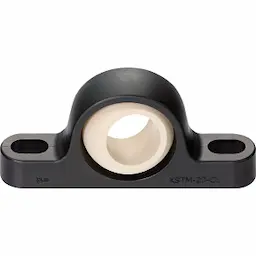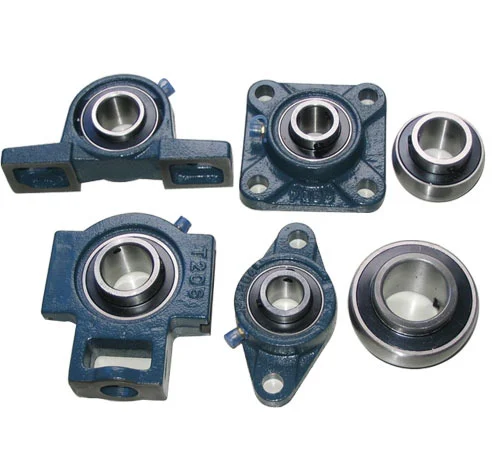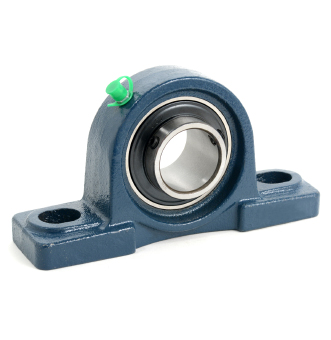
What challenges are associated with lubrication distribution in pillow block bearings, and how are they addressed?
Lubrication distribution in pillow block bearings can pose certain challenges, but these challenges can be effectively addressed through various methods and techniques. Here are the key challenges associated with lubrication distribution in pillow block bearings and their corresponding solutions:
- Inadequate Lubricant Supply:
- Lubricant Contamination:
- Uneven Lubrication Distribution:
- Over-Lubrication:
- Lubricant Degradation:
- Automatic Lubrication Systems:
One common challenge is ensuring an adequate and consistent supply of lubricant to the bearing. Inadequate lubrication can lead to increased friction, heat generation, and premature wear. To address this challenge, proper lubrication procedures should be followed, including using the correct type and quantity of lubricant recommended by the bearing manufacturer. Regular lubrication inspections and monitoring can help ensure that the bearing receives sufficient lubricant to maintain optimal performance.
Contamination of the lubricant can occur due to various factors, such as the ingress of dirt, dust, or moisture into the bearing housing. Contaminated lubricant can hinder proper lubrication distribution and compromise the bearing’s performance. To address this challenge, effective sealing mechanisms, such as rubber seals or labyrinth seals, are incorporated into pillow block bearings to prevent the entry of contaminants. Regular inspection and cleaning of the bearing housing and lubrication system can also help maintain a clean lubricant supply.
Uneven distribution of lubricant within the bearing can lead to localized areas of high friction and increased wear. This can occur due to factors such as improper lubrication techniques, misalignment, or the presence of obstructions within the bearing housing. To address this challenge, it is crucial to follow the manufacturer’s guidelines for lubrication methods and intervals. Proper alignment of the bearing and shafts, along with regular inspection and maintenance, can help ensure even lubricant distribution and prevent premature wear.
Over-lubrication can be as detrimental as inadequate lubrication. Excessive lubricant can result in increased drag, higher operating temperatures, and potential leakage. It can also lead to the accumulation of contaminants within the bearing housing. To overcome this challenge, it is essential to adhere to the recommended lubrication quantities specified by the bearing manufacturer. Monitoring techniques, such as visual inspection or the use of condition monitoring tools, can help identify signs of over-lubrication and allow for adjustments to be made accordingly.
Lubricants can degrade over time due to factors such as oxidation, contamination, or high operating temperatures. Degraded lubricants lose their effectiveness, leading to inadequate lubrication and increased friction. To address this challenge, regular lubricant analysis and monitoring can help determine the lubricant’s condition and identify the need for replenishment or replacement. Lubricant selection should also consider the operating conditions and temperature ranges to ensure optimal performance and longevity.
Pillow block bearings in certain applications benefit from the use of automatic lubrication systems. These systems provide a controlled and consistent supply of lubricant to the bearing, eliminating the challenges associated with manual lubrication. Automatic lubrication systems can be designed to deliver precise amounts of lubricant at regular intervals, ensuring optimal lubrication distribution. They can also incorporate monitoring features to detect abnormalities or malfunctions in the lubrication system and allow for timely corrective actions.
In summary, challenges associated with lubrication distribution in pillow block bearings include inadequate lubricant supply, lubricant contamination, uneven distribution, over-lubrication, lubricant degradation, and the need for precise and consistent lubrication. These challenges can be effectively addressed through proper lubrication procedures, sealing mechanisms, regular inspection and maintenance, adherence to manufacturer guidelines, monitoring techniques, lubricant analysis, and the use of automatic lubrication systems where applicable. By addressing these challenges, optimal lubrication distribution can be achieved, leading to improved performance, reduced wear, and extended bearing life.

Are there specific maintenance practices that can extend the lifespan of pillow block bearings?
Yes, there are specific maintenance practices that can help extend the lifespan of pillow block bearings. By following these practices, you can optimize the performance, reliability, and longevity of the bearings. Here are some essential maintenance practices for pillow block bearings:
- Regular Inspection:
- Lubrication:
- Cleanliness:
- Alignment:
- Temperature Monitoring:
- Training and Documentation:
- Replacement when Necessary:
Perform regular inspections of the pillow block bearings to check for any signs of wear, damage, or contamination. Inspect the bearing housing, seals, lubrication, and any visible components. Regular inspections help identify issues early on and allow for timely maintenance or replacement.
Proper lubrication is crucial for the smooth operation of pillow block bearings. Follow the manufacturer’s recommendations for the type of lubricant and the appropriate lubrication intervals. Ensure that the bearing is adequately lubricated to reduce friction, prevent excessive wear, and protect against corrosion.
Maintain cleanliness in the surrounding area of pillow block bearings to prevent the entry of contaminants. Keep the bearing housing clean and free from dirt, dust, and debris that can cause damage or hinder smooth operation. Regularly clean the bearing housing and seals as part of your maintenance routine.
Ensure proper alignment of the pillow block bearings and the associated components. Misalignment can lead to increased stress, vibration, and premature wear. Align the bearings according to the manufacturer’s specifications and make adjustments as necessary to maintain proper alignment.
Monitor the operating temperature of the pillow block bearings. Excessive heat can indicate potential issues such as inadequate lubrication or bearing damage. Continuously high temperatures can accelerate wear and reduce the lifespan of the bearings. Regularly check the temperature and address any abnormal readings promptly.
Provide proper training to personnel responsible for the maintenance of pillow block bearings. Ensure they understand the correct procedures for inspection, lubrication, and other maintenance tasks. Maintain documentation of maintenance activities, including lubrication schedules, inspections, and any repairs or replacements, for reference and tracking purposes.
Finally, it is important to replace pillow block bearings when they show signs of significant wear, damage, or have reached their expected lifespan. Continuing to operate with worn or damaged bearings can lead to failures, production disruptions, and potential safety hazards. Follow the manufacturer’s recommendations and consult with bearing specialists or technicians to determine the appropriate timing for replacement.
By implementing these maintenance practices, you can extend the lifespan of pillow block bearings, improve their performance, and minimize the risk of unexpected failures. Regular inspections, proper lubrication, cleanliness, alignment, temperature monitoring, training, documentation, and timely replacement are key factors in ensuring the longevity and efficient operation of pillow block bearings.

Can you explain the design principles of pillow block bearings and their functions?
Pillow block bearings, also known as plummer block bearings, are designed based on certain principles to ensure their functionality and performance. Understanding the design principles can provide insights into how these bearings operate and fulfill their intended functions. Here’s a detailed explanation of the design principles of pillow block bearings and their functions:
- Housing Design:
- Bearing Insert:
- Self-Aligning Capability:
- Load Support:
- Lubrication:
- Environmental Protection:
The housing of a pillow block bearing is typically made of cast iron or pressed steel and has a split design. The split housing allows for easy installation and maintenance by providing access to the bearing insert without the need to disassemble the entire system. The housing also includes mounting holes or slots for attaching the bearing to a support structure, such as a machine frame or conveyor system.
The bearing insert is a key component of a pillow block bearing. It is pre-mounted inside the housing and provides the rotating element to support shafts or other moving parts. The design of the bearing insert depends on the specific application requirements. Common types of bearing inserts used in pillow block bearings include deep groove ball bearings, spherical roller bearings, and cylindrical roller bearings. The selection of the appropriate bearing insert depends on factors such as load capacity, speed, and environmental conditions.
Pillow block bearings are designed with a certain degree of self-aligning capability. This means that they can accommodate slight misalignments or shaft deflections without causing undue stress on the bearing or affecting its performance. The self-aligning capability is achieved through the design of the bearing insert and the housing. It helps to ensure smooth operation, reduce wear, and prolong the bearing’s service life.
Pillow block bearings are primarily designed to support rotating shafts and transmit loads between the shaft and the housing. They are capable of handling both radial and axial loads, depending on the type of bearing insert used. The design of the bearing insert and the housing is optimized to provide optimal load-carrying capacity and distribute the loads evenly, minimizing stress concentrations and maximizing the bearing’s performance.
Lubrication is crucial for the proper functioning and longevity of pillow block bearings. The housing design often includes provisions for grease or oil lubrication. Lubrication helps to reduce friction, dissipate heat, prevent wear, and protect against corrosion. Proper lubrication ensures smooth operation, minimizes power losses, and extends the service life of the bearing.
Pillow block bearings are designed to provide a degree of environmental protection to the bearing insert. The housing acts as a shield, preventing contaminants such as dust, dirt, and moisture from entering the bearing and causing premature failure. The housing design may include features such as seals or shields to further enhance the protection against contaminants. This design principle helps to maintain the integrity of the lubrication and ensure reliable operation in various working environments.
In summary, pillow block bearings are designed based on certain principles to ensure their functionality and performance. The housing design allows for easy installation and maintenance, while the bearing insert provides the rotating element to support shafts and transmit loads. The self-aligning capability accommodates misalignments, and the optimized design of the bearing insert and housing ensures proper load support. Lubrication and environmental protection features contribute to smooth operation and extended service life. Understanding these design principles helps in selecting and utilizing pillow block bearings effectively in various industrial applications.


editor by CX 2024-05-08